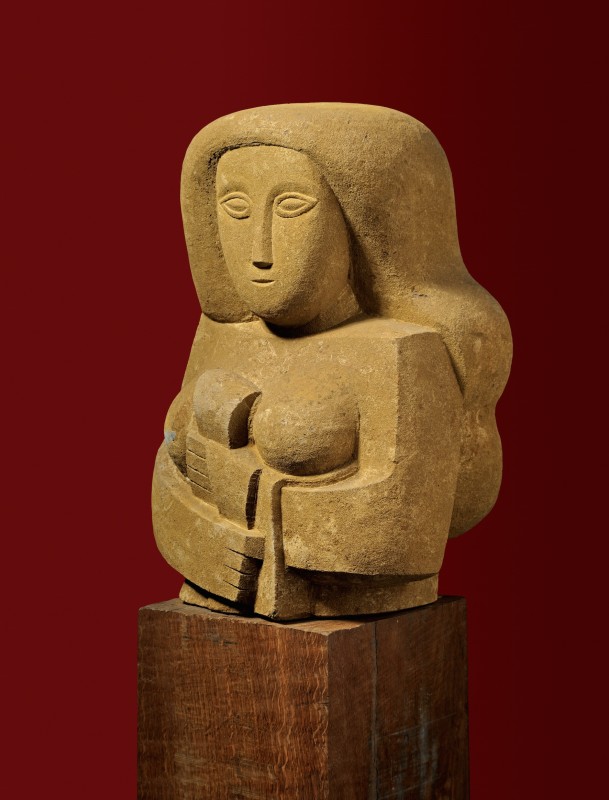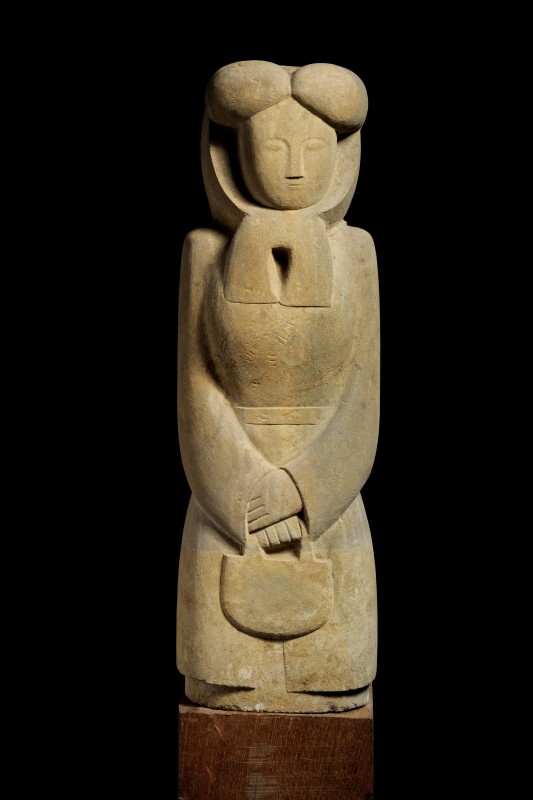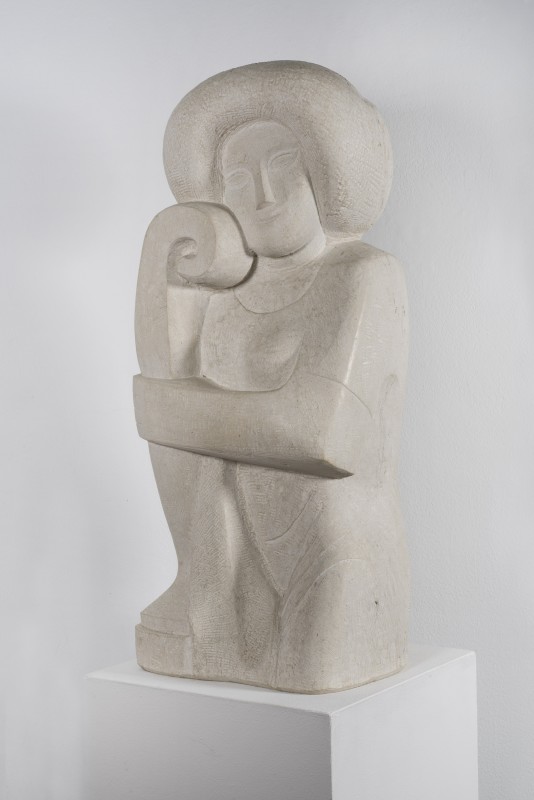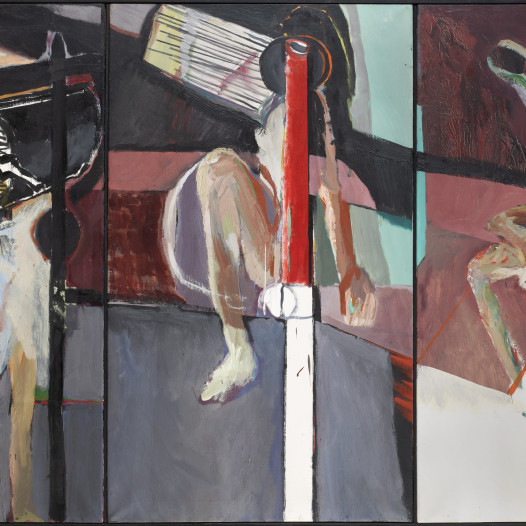George Kennethson
1910–1994George Kennethson was born in 1910, in Richmond upon Thames, and, in 1927, studied at St. John’s Wood School of Art, under Pat Millard. Two years later, he moved to the Royal Academy Painting Schools, where he remained until 1932. Kennethson primarily focused on painting, but, by 1936, he started to make small terracotta models for future stone carvings and sculptures. He disliked the traditionalism of the Royal Academy, and was far more interested in Modernism—his paintings had been greatly influenced by Cezanne’s treatment of elemental forms. At the Royal Academy Schools, he met his future wife, the textile designer and painter Eileen Guthrie, with whom he had five children.
Kennethson started to make frequent trips to the Isle of Purbeck, in Dorset, where he was inspired by the native stone, as well as the natural phenomena of the tombolo—birds overhead, the sea below. He soon turned away from painting and became primarily a sculptor.
Kennethson and Guthrie moved, in 1954, from Oxfordshire to Oundle. There, Kennethson took up a job as Art Master at the eponymous school. He had one day a week set aside for his personal work, and, in the late ’50s, he carved ‘The Serpent of Knowledge' on the wall of the school science block. Around this time, in 1959, he bought a defunct brewery in town and converted it into a studio and living space. Kennethson created mainly small-scale works in this studio, forms inspired by Epstein and Gaudier-Brzeska, as well as the ‘primitive’ pieces that he had seen as a student. These stone sculptures are solid, dense, with an emphasis on tactility and the versatility of his materials. They are intensely connected both to the stone from which they are carved, but also to the land from which this rock came. With this deep connection to the earth came a strong sense of the importance of peace and harmony with the natural and human worlds, something that Kennethson showed through his sculptures. One can also see the influence of the Ballet Russes and an early interest in dance demonstrated in the elegance and flowing movement of his forms, shapes that reflect waves and the soft, stylised human figure.
Kennethson unfortunately was largely unrecognised, however later in life he exhibited with the New Art Centre in London and Roche Court Sculpture Garden in Wiltshire. He is also represented in the Scottish National Gallery of Modern Art, and Kettle’s Yard, where he had a long-standing relationship with its founders, the Edes. In 2014, the Redfern Gallery mounted a significant exhibition of his small sculptures, in peach alabaster and clipsham.
Works
-
 George KennethsonRock: Sea Piece, 1955 (c.)Clipsham42 x 33 x 30 cm%3Cdiv%20class%3D%22artist%22%3E%3Cspan%20class%3D%22artist%22%3E%3Cstrong%3EGeorge%20Kennethson%3C/strong%3E%3C/span%3E%3C/div%3E%0D%3Cdiv%20class%3D%22title%22%3E%3Cem%3ERock%3A%20Sea%20Piece%3C/em%3E%2C%201955%20%28c.%29%3C/div%3E%0D%3Cdiv%20class%3D%22medium%22%3EClipsham%3C/div%3E%0D%3Cdiv%20class%3D%22dimensions%22%3E42%20x%2033%20x%2030%20cm%3C/div%3E
George KennethsonRock: Sea Piece, 1955 (c.)Clipsham42 x 33 x 30 cm%3Cdiv%20class%3D%22artist%22%3E%3Cspan%20class%3D%22artist%22%3E%3Cstrong%3EGeorge%20Kennethson%3C/strong%3E%3C/span%3E%3C/div%3E%0D%3Cdiv%20class%3D%22title%22%3E%3Cem%3ERock%3A%20Sea%20Piece%3C/em%3E%2C%201955%20%28c.%29%3C/div%3E%0D%3Cdiv%20class%3D%22medium%22%3EClipsham%3C/div%3E%0D%3Cdiv%20class%3D%22dimensions%22%3E42%20x%2033%20x%2030%20cm%3C/div%3E -
 George KennethsonCoronation, 1953Hornton64 x 24 x 23 cm%3Cdiv%20class%3D%22artist%22%3E%3Cspan%20class%3D%22artist%22%3E%3Cstrong%3EGeorge%20Kennethson%3C/strong%3E%3C/span%3E%3C/div%3E%0D%3Cdiv%20class%3D%22title%22%3E%3Cem%3ECoronation%3C/em%3E%2C%201953%3C/div%3E%0D%3Cdiv%20class%3D%22medium%22%3EHornton%3C/div%3E%0D%3Cdiv%20class%3D%22dimensions%22%3E64%20x%2024%20x%2023%20cm%3C/div%3E
George KennethsonCoronation, 1953Hornton64 x 24 x 23 cm%3Cdiv%20class%3D%22artist%22%3E%3Cspan%20class%3D%22artist%22%3E%3Cstrong%3EGeorge%20Kennethson%3C/strong%3E%3C/span%3E%3C/div%3E%0D%3Cdiv%20class%3D%22title%22%3E%3Cem%3ECoronation%3C/em%3E%2C%201953%3C/div%3E%0D%3Cdiv%20class%3D%22medium%22%3EHornton%3C/div%3E%0D%3Cdiv%20class%3D%22dimensions%22%3E64%20x%2024%20x%2023%20cm%3C/div%3E -
 George KennethsonSalome, 1950sAlabaster127 x 36 x 25 cm%3Cdiv%20class%3D%22artist%22%3E%3Cspan%20class%3D%22artist%22%3E%3Cstrong%3EGeorge%20Kennethson%3C/strong%3E%3C/span%3E%3C/div%3E%0D%3Cdiv%20class%3D%22title%22%3E%3Cem%3ESalome%3C/em%3E%2C%201950s%3C/div%3E%0D%3Cdiv%20class%3D%22medium%22%3EAlabaster%3C/div%3E%0D%3Cdiv%20class%3D%22dimensions%22%3E127%20x%2036%20x%2025%20cm%3C/div%3E
George KennethsonSalome, 1950sAlabaster127 x 36 x 25 cm%3Cdiv%20class%3D%22artist%22%3E%3Cspan%20class%3D%22artist%22%3E%3Cstrong%3EGeorge%20Kennethson%3C/strong%3E%3C/span%3E%3C/div%3E%0D%3Cdiv%20class%3D%22title%22%3E%3Cem%3ESalome%3C/em%3E%2C%201950s%3C/div%3E%0D%3Cdiv%20class%3D%22medium%22%3EAlabaster%3C/div%3E%0D%3Cdiv%20class%3D%22dimensions%22%3E127%20x%2036%20x%2025%20cm%3C/div%3E -
 George KennethsonFemale Form, 1940sBrown hornton39 x 27 x 22 cm%3Cdiv%20class%3D%22artist%22%3E%3Cspan%20class%3D%22artist%22%3E%3Cstrong%3EGeorge%20Kennethson%3C/strong%3E%3C/span%3E%3C/div%3E%0D%3Cdiv%20class%3D%22title%22%3E%3Cem%3EFemale%20Form%3C/em%3E%2C%201940s%3C/div%3E%0D%3Cdiv%20class%3D%22medium%22%3EBrown%20hornton%3C/div%3E%0D%3Cdiv%20class%3D%22dimensions%22%3E39%20x%2027%20x%2022%20cm%3C/div%3E
George KennethsonFemale Form, 1940sBrown hornton39 x 27 x 22 cm%3Cdiv%20class%3D%22artist%22%3E%3Cspan%20class%3D%22artist%22%3E%3Cstrong%3EGeorge%20Kennethson%3C/strong%3E%3C/span%3E%3C/div%3E%0D%3Cdiv%20class%3D%22title%22%3E%3Cem%3EFemale%20Form%3C/em%3E%2C%201940s%3C/div%3E%0D%3Cdiv%20class%3D%22medium%22%3EBrown%20hornton%3C/div%3E%0D%3Cdiv%20class%3D%22dimensions%22%3E39%20x%2027%20x%2022%20cm%3C/div%3E -
 George KennethsonStanding Female Figure, 1935 (c.)Brown hornton81 x 25 x 20 cm%3Cdiv%20class%3D%22artist%22%3E%3Cspan%20class%3D%22artist%22%3E%3Cstrong%3EGeorge%20Kennethson%3C/strong%3E%3C/span%3E%3C/div%3E%0D%3Cdiv%20class%3D%22title%22%3E%3Cem%3EStanding%20Female%20Figure%3C/em%3E%2C%201935%20%28c.%29%3C/div%3E%0D%3Cdiv%20class%3D%22medium%22%3EBrown%20hornton%3C/div%3E%0D%3Cdiv%20class%3D%22dimensions%22%3E81%20x%2025%20x%2020%20cm%3C/div%3E
George KennethsonStanding Female Figure, 1935 (c.)Brown hornton81 x 25 x 20 cm%3Cdiv%20class%3D%22artist%22%3E%3Cspan%20class%3D%22artist%22%3E%3Cstrong%3EGeorge%20Kennethson%3C/strong%3E%3C/span%3E%3C/div%3E%0D%3Cdiv%20class%3D%22title%22%3E%3Cem%3EStanding%20Female%20Figure%3C/em%3E%2C%201935%20%28c.%29%3C/div%3E%0D%3Cdiv%20class%3D%22medium%22%3EBrown%20hornton%3C/div%3E%0D%3Cdiv%20class%3D%22dimensions%22%3E81%20x%2025%20x%2020%20cm%3C/div%3E -
 George KennethsonFemale FigureWhite Purbeck65 x 25 x 23 cm%3Cdiv%20class%3D%22artist%22%3E%3Cspan%20class%3D%22artist%22%3E%3Cstrong%3EGeorge%20Kennethson%3C/strong%3E%3C/span%3E%3C/div%3E%0D%3Cdiv%20class%3D%22title%22%3E%3Cem%3EFemale%20Figure%3C/em%3E%3C/div%3E%0D%3Cdiv%20class%3D%22medium%22%3EWhite%20Purbeck%3C/div%3E%0D%3Cdiv%20class%3D%22dimensions%22%3E65%20x%2025%20x%2023%20cm%3C/div%3E
George KennethsonFemale FigureWhite Purbeck65 x 25 x 23 cm%3Cdiv%20class%3D%22artist%22%3E%3Cspan%20class%3D%22artist%22%3E%3Cstrong%3EGeorge%20Kennethson%3C/strong%3E%3C/span%3E%3C/div%3E%0D%3Cdiv%20class%3D%22title%22%3E%3Cem%3EFemale%20Figure%3C/em%3E%3C/div%3E%0D%3Cdiv%20class%3D%22medium%22%3EWhite%20Purbeck%3C/div%3E%0D%3Cdiv%20class%3D%22dimensions%22%3E65%20x%2025%20x%2023%20cm%3C/div%3E -
 George KennethsonHead of a GirlWhite Purbeck40 x 20 x 25 cm%3Cdiv%20class%3D%22artist%22%3E%3Cspan%20class%3D%22artist%22%3E%3Cstrong%3EGeorge%20Kennethson%3C/strong%3E%3C/span%3E%3C/div%3E%0D%3Cdiv%20class%3D%22title%22%3E%3Cem%3EHead%20of%20a%20Girl%20%3C/em%3E%3C/div%3E%0D%3Cdiv%20class%3D%22medium%22%3EWhite%20Purbeck%3C/div%3E%0D%3Cdiv%20class%3D%22dimensions%22%3E40%20x%2020%20x%2025%20cm%3C/div%3E
George KennethsonHead of a GirlWhite Purbeck40 x 20 x 25 cm%3Cdiv%20class%3D%22artist%22%3E%3Cspan%20class%3D%22artist%22%3E%3Cstrong%3EGeorge%20Kennethson%3C/strong%3E%3C/span%3E%3C/div%3E%0D%3Cdiv%20class%3D%22title%22%3E%3Cem%3EHead%20of%20a%20Girl%20%3C/em%3E%3C/div%3E%0D%3Cdiv%20class%3D%22medium%22%3EWhite%20Purbeck%3C/div%3E%0D%3Cdiv%20class%3D%22dimensions%22%3E40%20x%2020%20x%2025%20cm%3C/div%3E -
 George KennethsonLandscapeBlue clipsham17 x 36 x 38 cm%3Cdiv%20class%3D%22artist%22%3E%3Cspan%20class%3D%22artist%22%3E%3Cstrong%3EGeorge%20Kennethson%3C/strong%3E%3C/span%3E%3C/div%3E%0D%3Cdiv%20class%3D%22title%22%3E%3Cem%3ELandscape%3C/em%3E%3C/div%3E%0D%3Cdiv%20class%3D%22medium%22%3EBlue%20clipsham%3C/div%3E%0D%3Cdiv%20class%3D%22dimensions%22%3E17%20x%2036%20x%2038%20cm%3C/div%3E
George KennethsonLandscapeBlue clipsham17 x 36 x 38 cm%3Cdiv%20class%3D%22artist%22%3E%3Cspan%20class%3D%22artist%22%3E%3Cstrong%3EGeorge%20Kennethson%3C/strong%3E%3C/span%3E%3C/div%3E%0D%3Cdiv%20class%3D%22title%22%3E%3Cem%3ELandscape%3C/em%3E%3C/div%3E%0D%3Cdiv%20class%3D%22medium%22%3EBlue%20clipsham%3C/div%3E%0D%3Cdiv%20class%3D%22dimensions%22%3E17%20x%2036%20x%2038%20cm%3C/div%3E -
 George KennethsonReclining FigureClipsham41 x 71 x 17 cm%3Cdiv%20class%3D%22artist%22%3E%3Cspan%20class%3D%22artist%22%3E%3Cstrong%3EGeorge%20Kennethson%3C/strong%3E%3C/span%3E%3C/div%3E%0D%3Cdiv%20class%3D%22title%22%3E%3Cem%3EReclining%20Figure%3C/em%3E%3C/div%3E%0D%3Cdiv%20class%3D%22medium%22%3EClipsham%3C/div%3E%0D%3Cdiv%20class%3D%22dimensions%22%3E41%20x%2071%20x%2017%20cm%3C/div%3E
George KennethsonReclining FigureClipsham41 x 71 x 17 cm%3Cdiv%20class%3D%22artist%22%3E%3Cspan%20class%3D%22artist%22%3E%3Cstrong%3EGeorge%20Kennethson%3C/strong%3E%3C/span%3E%3C/div%3E%0D%3Cdiv%20class%3D%22title%22%3E%3Cem%3EReclining%20Figure%3C/em%3E%3C/div%3E%0D%3Cdiv%20class%3D%22medium%22%3EClipsham%3C/div%3E%0D%3Cdiv%20class%3D%22dimensions%22%3E41%20x%2071%20x%2017%20cm%3C/div%3E -
 George KennethsonSeated CoupleClipsham70 x 33 x 22 cm%3Cdiv%20class%3D%22artist%22%3E%3Cspan%20class%3D%22artist%22%3E%3Cstrong%3EGeorge%20Kennethson%3C/strong%3E%3C/span%3E%3C/div%3E%0D%3Cdiv%20class%3D%22title%22%3E%3Cem%3ESeated%20Couple%3C/em%3E%3C/div%3E%0D%3Cdiv%20class%3D%22medium%22%3EClipsham%3C/div%3E%0D%3Cdiv%20class%3D%22dimensions%22%3E70%20x%2033%20x%2022%20cm%3C/div%3E
George KennethsonSeated CoupleClipsham70 x 33 x 22 cm%3Cdiv%20class%3D%22artist%22%3E%3Cspan%20class%3D%22artist%22%3E%3Cstrong%3EGeorge%20Kennethson%3C/strong%3E%3C/span%3E%3C/div%3E%0D%3Cdiv%20class%3D%22title%22%3E%3Cem%3ESeated%20Couple%3C/em%3E%3C/div%3E%0D%3Cdiv%20class%3D%22medium%22%3EClipsham%3C/div%3E%0D%3Cdiv%20class%3D%22dimensions%22%3E70%20x%2033%20x%2022%20cm%3C/div%3E -
 George KennethsonSeated FigureAlabaster51 x 30 x 21 cm%3Cdiv%20class%3D%22artist%22%3E%3Cspan%20class%3D%22artist%22%3E%3Cstrong%3EGeorge%20Kennethson%3C/strong%3E%3C/span%3E%3C/div%3E%0D%3Cdiv%20class%3D%22title%22%3E%3Cem%3ESeated%20Figure%3C/em%3E%3C/div%3E%0D%3Cdiv%20class%3D%22medium%22%3EAlabaster%3C/div%3E%0D%3Cdiv%20class%3D%22dimensions%22%3E51%20x%2030%20x%2021%20cm%3C/div%3E
George KennethsonSeated FigureAlabaster51 x 30 x 21 cm%3Cdiv%20class%3D%22artist%22%3E%3Cspan%20class%3D%22artist%22%3E%3Cstrong%3EGeorge%20Kennethson%3C/strong%3E%3C/span%3E%3C/div%3E%0D%3Cdiv%20class%3D%22title%22%3E%3Cem%3ESeated%20Figure%3C/em%3E%3C/div%3E%0D%3Cdiv%20class%3D%22medium%22%3EAlabaster%3C/div%3E%0D%3Cdiv%20class%3D%22dimensions%22%3E51%20x%2030%20x%2021%20cm%3C/div%3E -
 George KennethsonWavesClipsham35 x 26 x 24 cm%3Cdiv%20class%3D%22artist%22%3E%3Cspan%20class%3D%22artist%22%3E%3Cstrong%3EGeorge%20Kennethson%3C/strong%3E%3C/span%3E%3C/div%3E%0D%3Cdiv%20class%3D%22title%22%3E%3Cem%3EWaves%3C/em%3E%3C/div%3E%0D%3Cdiv%20class%3D%22medium%22%3EClipsham%3C/div%3E%0D%3Cdiv%20class%3D%22dimensions%22%3E35%20x%2026%20x%2024%20cm%3C/div%3E
George KennethsonWavesClipsham35 x 26 x 24 cm%3Cdiv%20class%3D%22artist%22%3E%3Cspan%20class%3D%22artist%22%3E%3Cstrong%3EGeorge%20Kennethson%3C/strong%3E%3C/span%3E%3C/div%3E%0D%3Cdiv%20class%3D%22title%22%3E%3Cem%3EWaves%3C/em%3E%3C/div%3E%0D%3Cdiv%20class%3D%22medium%22%3EClipsham%3C/div%3E%0D%3Cdiv%20class%3D%22dimensions%22%3E35%20x%2026%20x%2024%20cm%3C/div%3E






